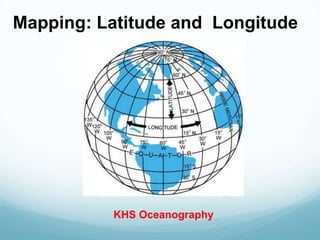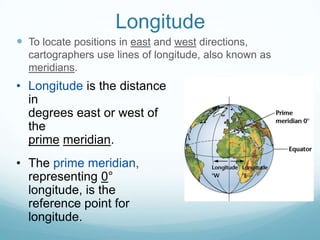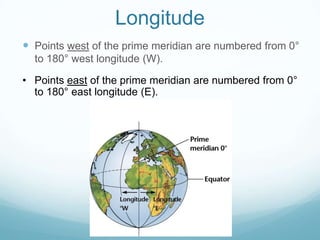4 longitude and latitude
- 1. Mapping: Latitude and Longitude KHS Oceanography
- 2. Latitude and Longitude âĒ Cartographers use an imaginary grid of parallel lines and vertical lines to locate points on Earth. âĒ The equator circles Earth halfway between the north and south poles separating Earth into two equal halves called the northern hemisphere and the southern hemisphere.
- 3. Latitude ï Lines of latitude are lines running parallel to the equator. âĒ Latitude is the distance in degrees north or south of the equator.
- 4. Latitude ï Latitude is thus measured from 0° at the equator to 90° at the poles. âĒ Locations north of the equator are referred to by degrees north latitude (N). âĒ Locations south of the equator are referred to by degrees south latitude (S).
- 5. Degrees of Latitude Latitude â Each degree of latitude is equivalent to about 111 km ( ) on Earthâs surface. 1° = 70 miles â To locate positions on Earth more precisely, cartographers break down degrees of latitude into 60 smaller units, called minutes (Âī). 1' = 1.2 miles â A minute of latitude can be further divided into seconds (ÂīÂī). 1" = .02 miles â Longitude is also divided into degrees, minutes, and seconds.
- 6. Longitude ï To locate positions in east and west directions, cartographers use lines of longitude, also known as meridians. âĒ Longitude is the distance in degrees east or west of the prime meridian. âĒ The prime meridian, representing 0° longitude, is the reference point for longitude.
- 7. Longitude ï Points west of the prime meridian are numbered from 0° to 180° west longitude (W). âĒ Points east of the prime meridian are numbered from 0° to 180° east longitude (E).







